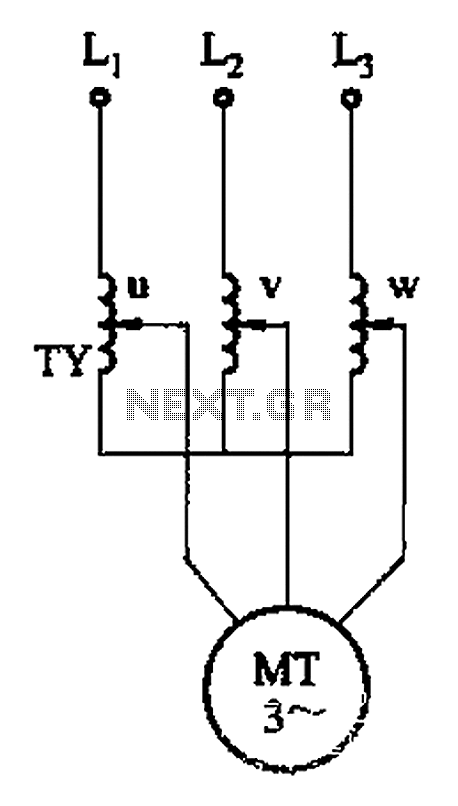
Light control circuit diagram

The circuit utilizes a standard telephone ringing circuit, KA2401, along with additional components to control lighting in response to a ringing signal. The light control circuit can be activated externally by AC when the ringing signal is received. The KA2401 generates two 8-pin output signals for the ringing tone. During daylight, the resistance of the photodiode (3DU) is low, which causes the thyristor (SCR) to turn on, resulting in a louder ringing. Conversely, at night, the resistance of the photodiode increases significantly (in the megaohm range), allowing only a reduced ringing signal to pass through resistor R2, which diminishes the ringing sound.
The described circuit effectively integrates a telephone ringing signal with a light control mechanism, employing the KA2401 as the core component. The KA2401 is a specific integrated circuit designed to generate ringing signals for telecommunication applications. It provides dual output signals that can be utilized to trigger other electronic components within the circuit.
The operation of the light control circuit hinges on the behavior of the photodiode (3DU). During the day, when ambient light levels are high, the photodiode exhibits low resistance, allowing for sufficient current flow to activate the thyristor (SCR). This activation results in a pronounced ringing sound, suitable for daytime conditions when background noise may mask quieter signals.
In contrast, the circuit is designed to adapt to nighttime conditions. As the light diminishes, the resistance of the photodiode increases significantly, which alters the functioning of the circuit. The higher resistance limits the current that can flow through the thyristor, thereby reducing the overall ringing signal. This is further influenced by the presence of resistor R2, which acts to attenuate the ringing signal even more, ensuring that it remains subtle and less intrusive during nighttime hours.
The implementation of this circuit is advantageous in environments where it is necessary to manage sound levels based on the time of day, providing a practical solution for residential or commercial applications. The use of the KA2401 in conjunction with the photodiode and thyristor creates a responsive system that balances functionality with user comfort.Use of ordinary telephone ringing circuit KA2401 and peripheral components, the installation of the light control when the bell simply access in the country (a) the "X" at the country (b), the light control circuit can be: external AC when the ringing signal input, KA2401 two 8-pin output signal ringing tone, if during the day, photodiodes 3DU resistance is small, the thyristor SCR turns on, ringing larger; if no light at night, 3DU resistance is (number Meg), only through the ringing signal attenuation by R2, ringing much smaller.
The described circuit effectively integrates a telephone ringing signal with a light control mechanism, employing the KA2401 as the core component. The KA2401 is a specific integrated circuit designed to generate ringing signals for telecommunication applications. It provides dual output signals that can be utilized to trigger other electronic components within the circuit.
The operation of the light control circuit hinges on the behavior of the photodiode (3DU). During the day, when ambient light levels are high, the photodiode exhibits low resistance, allowing for sufficient current flow to activate the thyristor (SCR). This activation results in a pronounced ringing sound, suitable for daytime conditions when background noise may mask quieter signals.
In contrast, the circuit is designed to adapt to nighttime conditions. As the light diminishes, the resistance of the photodiode increases significantly, which alters the functioning of the circuit. The higher resistance limits the current that can flow through the thyristor, thereby reducing the overall ringing signal. This is further influenced by the presence of resistor R2, which acts to attenuate the ringing signal even more, ensuring that it remains subtle and less intrusive during nighttime hours.
The implementation of this circuit is advantageous in environments where it is necessary to manage sound levels based on the time of day, providing a practical solution for residential or commercial applications. The use of the KA2401 in conjunction with the photodiode and thyristor creates a responsive system that balances functionality with user comfort.Use of ordinary telephone ringing circuit KA2401 and peripheral components, the installation of the light control when the bell simply access in the country (a) the "X" at the country (b), the light control circuit can be: external AC when the ringing signal input, KA2401 two 8-pin output signal ringing tone, if during the day, photodiodes 3DU resistance is small, the thyristor SCR turns on, ringing larger; if no light at night, 3DU resistance is (number Meg), only through the ringing signal attenuation by R2, ringing much smaller.





